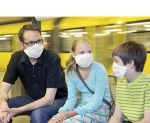Terrorism is defined as the use of force or violence against people and property.
 That action is labeled BIOTERRORISM when the violence involves the intentional release of a biological agent (such as bacteria, viruses or toxins).
That action is labeled BIOTERRORISM when the violence involves the intentional release of a biological agent (such as bacteria, viruses or toxins).
Bacteria and viruses are microorganisms that live among us both in harmony and with malice. When these microorganisms cause severe illness or death, they make excellent terrorists tools; and they’re classified as “biological” whether they occur naturally or are modified by humans in a lab.
A toxin is a poisonous byproduct produced by such microorganisms and is as deadly as the organisms themselves. That means the “bug” can be killed but the toxin can linger behind and create substantial havoc on its own, such as contaminated food harboring the botulism toxin.
So we have biological agents (bacteria, viruses or toxins) that can be used as weapons of mass destruction by simply spreading them into the air, our water supply or along the food chain.
mass destruction by simply spreading them into the air, our water supply or along the food chain.
They can kill instantly upon contact or cause death slowly over several hours or days, making it difficult to detect the origin. And identification of the source can be even more complicated when agents spread from person to person (a contagious biological agent).
Further hurdles to effective protection occur when we realize how easy it is to use these agents. They’re relatively inexpensive to obtain (as opposed to something like a nuclear weapon), are highly portable and can be disseminated easily among the population.
 With all the possible types of biologicals and the ways in which they can be spread, it would seem to be a monumental task to plan anything of appreciable value to prevent such an attack. And that’s the central focus of bio-defense, the medical measures in place to protect people against biological agents.
With all the possible types of biologicals and the ways in which they can be spread, it would seem to be a monumental task to plan anything of appreciable value to prevent such an attack. And that’s the central focus of bio-defense, the medical measures in place to protect people against biological agents.
In blockbuster films that have concentrated on bioterrorism, vaccines against the deadly contagion are developed within a few weeks or months, but that’s not reality.
The Transformational Medical Technologies initiative started by the Department of Defense in 2006 set out to identify and develop broad-spectrum therapies that could be effective against multiple bacterial and viral pathogens, specifically to protect soldiers against biological attacks. In reality, the program produced no new specific treatments or antidotes and the program has ceased to exist as envisioned.
Now the U.S. government is focusing its attention on what’s called “The Big Six Biological Threats”. These are identified as anthrax, the plague, tularemia, the botulism toxin, smallpox and viral hemorrhagic fevers (like the Ebola virus). And these threats can be grouped so that a common treatment can be identified for categories of biological threats.
Anthrax, plague and tularemia are all bacterial agents and the fluoroquinolone (like ciprofloxacin and levofloxacin) antibiotic drugs that are already in existence are effective treatments.
ciprofloxacin and levofloxacin) antibiotic drugs that are already in existence are effective treatments.
Toxins, including botulism, often present as neurotoxins (causing nerve paralysis and respiratory failure) and the lack of any approved drug treatment other than supportive measures leaves a major gap in bio-defense. That’s a considerable area of exposure since the botulism neurotoxin is said to be the most poisonous substance known to man and is 10,000 times more deadly than cyanide poisoning.
 Effective treatments for viral biological agents also remain elusive. We have a smallpox vaccine for prevention and scientists are working on an Ebola vaccine, but there’s no specific treatment once these viruses cause sickness in those not already vaccinated. Recommended treatments are only supportive, like fluids, antibiotics for secondary infections, etc. – the same as for the common cold.
Effective treatments for viral biological agents also remain elusive. We have a smallpox vaccine for prevention and scientists are working on an Ebola vaccine, but there’s no specific treatment once these viruses cause sickness in those not already vaccinated. Recommended treatments are only supportive, like fluids, antibiotics for secondary infections, etc. – the same as for the common cold.
Presently, our government has been adjusting its approach to bio-defense and focusing on stockpiling currently available antibiotics and antiviral agents without creating shortages for the rest of the population. In essence, we are back to square one regarding treatment protection against biologicals.
For a comprehensive review of the current status of how well the United States is defending itself against biological attacks, I have not found a better resource than a feature article called Biological Attack—Are We Ready? that I found on the Security Degree Hub website. Click here to link to that informative article!
Fortunately, increased and more effective intelligence of potential terrorist plots have been successful in keeping us safe to this point. But that safety net is a fragile element in our protection system and provides fertile opportunity to create interesting terror plots in our writing to launch our protagonists into superhero action.
Thoughts? Comments? I’d love to hear them!

Awesome! I like your starting words to keep the visitor stay and read your full blog post. Anyhow the overall post is really informative and contains tons of knowledgeable factors. Thank u so much for sharing this post.I wanna share some information about medicine manufacturers for you.Please visit:
medicine manufacturers
Thanks for reading and following, and thanks for sharing your thoughts. All the best!